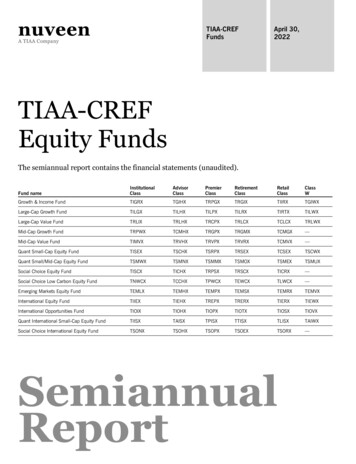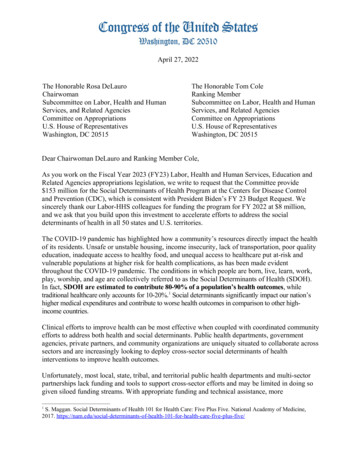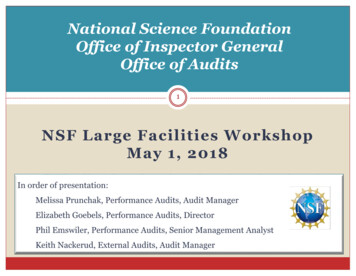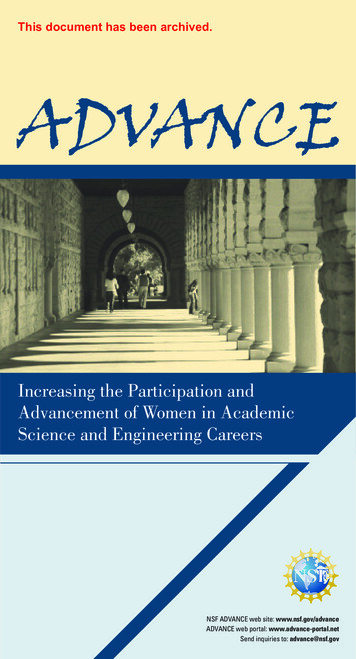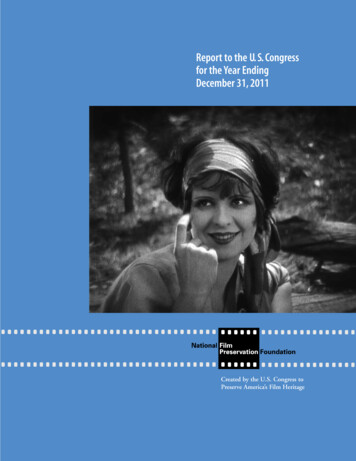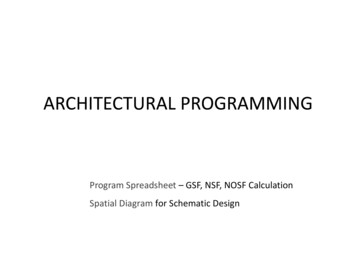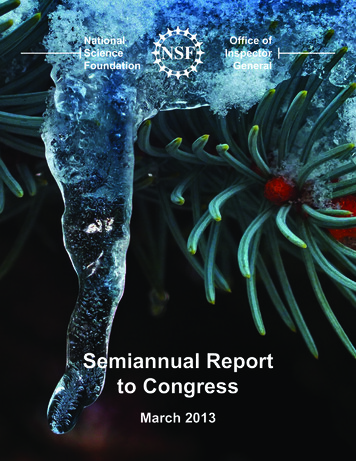
Transcription
NationalScienceFoundationOffice ofInspectorGeneralSemiannual Reportto CongressMarch 2013
About The National Science Foundation.The National Science Foundation (NSF) is charged with supporting and strengthening allresearch discplines, and providing leadership across the broad and expanding frontiers ofscience and engineering knowledge. It is governed by the National Science Board whichsets agency policies and provides oversight of its activities.NSF invests approximately 7 billion per year in a portfolio of more than 35,000 researchand education projects in science and engineering, and is responsible for the establishmentof an information base for science and engineering appropriate for development of nationaland international policy. Over time other responsibilities have been added including fostering and supporting the development and use of computers and other scientific methods andtechnologies; providing Antarctic research, facilities and logistic support; and addressingissues of equal opportunity in science and engineering.And The Office of the Inspector General.NSF’s Office of the Inspector General promotes economy, efficiency, and effectiveness inadministering the Foundation’s programs; detects and prevents fraud, waste, and abusewithin the NSF or by individuals that recieve NSF funding; and identifies and helps toresolve cases of misconduct in science. The OIG was established in 1989, in compliancewith the Inspector General Act of 1978, as amended. Because the Inspector Generalreports directly to the National Science Board and Congress, the Office is organizationallyindependent from the agency.
Table of ContentsFrom the Inspector General. 3Report Highlights. 5Audits and Reviews. 7NSF’s Use of IPAs .7Final Project Reports from NSF Grantees.8Questioned Costs at Two NSF Awardees.9Information Technology Security at NSF.11Sunshine Act Compliance.13Improper Payments Reporting.14Financial Statement Audit Reports.14NSF’s Response to Large Cooperative Agreements Alert Memo.15Audit Resolution.17A-133 Audits.18Investigations. 21Civil and Criminal Investigations.21Research Misconduct Investigations.25Administrative Investigations.33OIG Management Activities. 37Congressional Testimony.37Outreach.38Statistical Data. 41
From the Inspector GeneralThis Semiannual Report to Congress highlights the activities of the National Science Foundation (NSF), Office of Inspector General for the sixmonth period ending March 31, 2013. During this reporting period, tenreports and reviews were issued, two of which questioned more than 3million. Our investigative staff closed 72 civil/criminal and administrativeinvestigations, had seven research misconduct cases result in findingsby NSF, and recovered 1,661,928.88 for the government.The audits, investigations, and other work presented in this report reflectmy office’s attention to oversight issues that have a direct impact onthe Foundation’s ability to carry out its mission of advancing scientificresearch, which is accomplished primarily through funding externalawardees. It is essential that NSF rely on robust processes and procedures for awarding the taxpayer dollars entrusted to the Foundation as itworks to fulfill this mission.For more than two years, we have been recommending that NSF imposestronger cost surveillance measures for high-risk, high-dollar cooperative agreements used in large facility projects. NSF’s February 2013response to our September 2012 alert memo on this subject assertedthat its existing practices were sufficient to ensure adequate oversight forsuch cooperative agreements and disagreed with our recommendationsto strengthen accountability. The response heightened our concernsabout NSF’s accountability and monitoring over these cooperative agreements.In March, we received NSF’s assessment of the processes and policiesfor supporting large research facilities from conception to constructionto operation, which was conducted at the request of then NSF Director,Dr. Subra Suresh. We view this plan as a step in the right direction, butit is just a start. Implementing the vision articulated in this document willrequire commitment across the Foundation and leadership from the top.We continue to work with NSF to address the systemic problems relatingto oversight of cooperative agreements.We are also encouraging NSF to closely examine ways that it canreduce spending that could free up more money for research grants.Our audit of NSF’s use of the Intergovernmental Personnel Act to bringin scientists and other others as temporary staff found that NSF paid anannual additional cost of approximately 6.7 million for 184 IPAs in 2012.In that year, NSF paid 54 IPAs an annual salary exceeding the federalexecutive pay limit of 179,700. We recognize the value IPAs bring tothe Foundation and are not suggesting that NSF discontinue its use of
IPAs. However, in a time of austerity, it is particularly important to evaluate all costs andidentify opportunities for savings. We recommended that NSF evaluate ways to reduceIPA costs, including expanded use of telework, greater cost sharing by IPA home institutions, and reviewing fringe benefit rates. NSF concurred with our recommendation.Our investigations continue to aggressively pursue those who seek to fraudulentlyobtain and use funds intended for scientific research. During the past six months, forexample, a former professor was sentenced for using over 160,000 in NSF grant fundsto purchase items for personal use including cameras and binoculars, and a universitythat failed to adequately document and account for salary and stipends repaid 530,000to NSF.We referred eleven cases of research misconduct to NSF in the past six monthsand had seven findings of research misconduct for data falsification fabrication andplagiarism. It is imperative to the integrity of research funded with taxpayer dollars thatNSF-funded researchers carry out their projects with the highest ethical standards.My office’s work is guided by a firm and consistent commitment to help ensure thattaxpayer money intended to promote science is used properly. We will continue to workwith NSF to see that our recommendations to safeguard federal funds are implementedand to keep Congress fully informed of our progress. It is through this partnership andour shared mission of strengthening oversight of federal funds that greater accountability will be achieved.
Report Highlights Our audit of NSF’s use of the Intergovernmental Personnel Act (IPA) to bring scientists, engineers, and educatorsto NSF as temporary staff, found that NSF paid an additional cost of approximately 6.7 million, or an average ofover 36,000 per IPA, for 184 IPAs in FY 2012. We alsofound that in FY 2012, NSF paid 54 IPAs salary at levelsexceeding the federal executive pay limit of 179,700.While we do not question NSF’s authority to use IPAs,we did not find any evidence that the Foundation hadexamined the additional costs incurred as a result of usingIPAs or sought ways to reduce those costs. An audit of 218 million of direct costs claimed on threecooperative agreements identified more than 2.1 millionin questioned costs. The audit also disclosed significantnon-compliance with Federal Cost Accounting Standards. A joint investigation found that a public broadcastingcompany had submitted inadequate financial reports forfour years and had an inadequate accounting system fortracking grant expenditures. Following a civil settlement,the company is required to repay more than 273,000to NSF and enter into a five-year compliance plan tostrengthen its oversight of federal funds. Our investigation led to a Principal Investigator (PI) ofan NSF Small Business Technology Transfer programawardee company being indicted on several chargesbased upon proposals, reports, and payment requests hesubmitted which contained false information. In addition,the PI fabricated timesheets and altered financial recordsto conceal personal expenditures. A PI who charged personal purchases to NSF awardsresigned from his university and returned more than 160,000 to NSF. He pled guilty to theft and has beensentenced to two years probation.5
Report Highlights6
Audits & ReviewsNSF’s Use of IPAs Estimated to Cost anAdditional 6.7 Million AnnuallyNSF uses the Intergovernmental Personnel Act (IPA) as itsprimary way to bring top scientists, engineers, and educatorsfrom universities to NSF as temporary staff to maintain itsworld-class scientific workforce. IPAs remain employees oftheir home institution, and they are not subject to federal payand benefits limitations. As a result, IPAs can cost substantially more than federal employees in equivalent positions.Our audit to determine the additional costs of IPAs estimatedthat NSF paid an annual, additional cost of approximately 6.7 million, or an average of over 36,000 per IPA, for 184full-time IPAs in 2012.We found that in 2012, NSF paid 54 IPAs salary exceedingthe federal executive pay limit of 179,700. NSF paid 34 ofthese IPAs an annual salary of 200,000 or more with thehighest annual salary of 301,247 for an Assistant Director.In addition to these salary costs, we calculated that NSF paidnearly 800,000 in additional fringe benefit costs for IPAs andthat it paid 58 IPAs 337,823 in lost consulting in one year.Additional costs for temporary living expenses for IPAs cameto 1,438,696.Because NSF pays IPA costs out of program funds, reducingthese costs could free up more money for research grants.We do not question the fact that IPAs bring benefits to NSF,nor do we question NSF’s authority to use IPAs. However,in a time of austerity, it is important to evaluate all costs andidentify opportunities for savings. We did not find evidencethat NSF has examined the additional costs incurred as aresult of using IPAs or sought ways to reduce those costs.HIGHLIGHTSWe recommended that NSF evaluate ways to reduce IPAcosts, including expanded use of telework, greater costsharing by IPA home institutions, and reviewing fringe benefitrates. NSF concurred with our recommendation.NSF’s Use of IPAsEstimated to Cost anAdditional 6.7 MillionAnnually .7Information TechnologySecurity at NSF. 11NSF’ Response to LargeCooperative AgreementsAlert Memo . 15In addition, we did not find that anyone at NSF was responsible for measuring and documenting the impact of rotatingpersonnel, including IPAs, on the agency as a whole. As a7
Audits & Reviewsresult, the agency misses opportunities to assess these programs’ overallcontribution to NSF’s mission and goals. Given the number of IPAs atNSF at any given moment, their prevalence in the highest ranks of theagency, and the added costs that result from their use, it would be helpfulif NSF designated a champion responsible for overseeing and managingthe rotator programs as a whole.NSF Has Made Significant Improvements but More Effort is Neededto Ensure That Grantees Submit Required Project Reports in aTimely MannerWe conducted an audit to determine if NSF had implemented effectivecontrols over grantee project reporting since our 2004 audit. NSF usesproject reports from Principal Investigators (PIs) to monitor the progressand accomplishments of funded projects. We reviewed all annual and/or final project reports, approximately 55,500, which were due or overduebetween October 1, 2010 and March 31, 2012.We found that the percentage of final reports submitted late declinedfrom 53 percent in the 2004 audit to 20 percent, and the percentageof final reports not submitted declined from 8 percent to 5 percent.Similarly, the percentage of annual reports not submitted declined from42 percent to 2 percent. While the percentages of late and not submittedreports have declined significantly, they nonetheless represent almost12,000 final and annual reports submitted late and over 1,500 reports notsubmitted.When reports are submitted late or not at all, NSF cannot fully assessthe extent to which grantees have met their project goals. Withouttimely annual reports, NSF program officers may not be able to addresspotential problems that could impair satisfactory performance of a project.Finally, if NSF does not receive final reports in a timely manner, NSFmanagement may not be informed fully about the results and accomplishments of the research it funded.Some NSF program officers we interviewed were not aware that therequired reports for some of their awards were overdue several monthsor were submitted several months late because they were not monitoringthe status of overdue reports. According to some NSF program officers,NSF systems do not easily identify awards with project reports that wereoverdue for a prolonged period. Finally, we found that NSF’s key controlto withhold additional funding to any PI with a past due project reportcould be circumvented if the PI transferred to a different institution andobtained a new NSF identification number.8
OIG Semiannual ReportMarch 2013We recommended that NSF ensure that all performance reports aresubmitted on time and that it improve procedures to prevent assigning asecond identification number to PIs. NSF agreed with our recommendations and stated that it is planning actions to address them.In addition, during the course of this audit we identified a number ofindividual PIs who have repeatedly failed to comply with NSF’s reportingrequirements, including individuals with multiple missing final reports.In our view, such repeated non-compliance indicates a possible lack ofpresent responsibility to handle federal funds and we are exploring waysto address these situations, and potential government-wide suspensionor debarment, as appropriate.Noncompliance with Cost Accounting Standards Leads to More than 2.1 Million of Questioned Costs on Cooperative Agreements at theUniversity of Wisconsin-MadisonAn audit of 218 million of direct costs claimed on three cooperativeagreements at the University of Wisconsin to build the IceCube NeutrinoObservatory in Antarctica, found that the University’s claimed costs wereunacceptable as submitted because the University did not comply withFederal Cost Accounting Standards (CAS). While the audit identifiedmore than 2.1 million in questioned costs, the full impact of the noncompliance is not yet known.Following is a description of the four areas where Wisconsin did notcomply with CAS and did not consistently follow accounting practices inits CAS Disclosure Statement.1. The University reclassified two proposed subawards without properdocumentation or authorization from NSF. As a result, NSF wascharged an additional 2.1 million in indirect Facility and Administration (F&A) costs.2. The University’s accounting records did not segregate actualcontingency costs (i.e., those costs arising out of expenditures of theproposed 44 million in contingency funds) from other accumulatedcosts as required by CAS. When contingency funds were expended,Wisconsin commingled these expenditures among several direct costaccounts such as labor and equipment, and did not identify or maintain visibility of actual contingency costs or associated indirect coststhat resulted from the expenditure of contingency funds. As a result,this significant budgeted cost element could not be tracked or compared to actual costs. Such comparisons are a critical tool for financialcontrol over costs during award performance and aid in establishingaccountability for costs in the manner agreed to at the time of award.9
Audits & ReviewsIn addition, the university proposed contingency costs under thecategory “Other Direct Costs” on the proposal summary form submitted to NSF, but did not apply its indirect F&A rate to these contingencycosts. However, while UW did not maintain visibility of actual contingency costs in its accounting records, the audit found that as muchas 13.7 million of the 44 million of contingency costs, presentedto NSF on the proposal summary form as “Other Direct Costs,” mayhave been charged to NSF as indirect costs. As a result, NSF lackedknowledge of the proposed direct and indirect costs at the summarylevel which is necessary for it to make informed award decisions.3. Wisconsin commingled indirect F&A costs in a direct cost account,using manual calculations rather than the University’s automatedindirect cost charging process. As a result, budgeted F&A costs couldnot be compared with actual F&A costs as required by CAS. According to the University, it charged nearly 30 million of F&A costs to theproject. However the auditors could not determine if the Universitycorrectly applied its fixed F&A rate and whether indirect costs wereonly claimed on eligible direct costs.4. Wisconsin charged 6,785 in employee relocation costs as directcosts without providing the justification required by NSF and its CASDisclosure Statement.The full impact of Wisconsin’s noncompliance cannot be determined untilthe University submits revised incurred cost statements and NSF hasthose statements audited. Such statements and audits are essentialaccountability tools which the OIG has consistently recommended thatNSF require and obtain.The audit recommended that Wisconsin obtain proper documentationand NSF approval prior to reclassifying subawards; use its automatedmethod of calculating and recording F&A costs; segregate contingencycosts in its accounting records; clearly identify direct and indirectcontingency costs in its proposals to NSF; and revise its CAS DisclosureStatement to accurately and completely describe its accounting practicesrelated to contingency costs; and repay all disallowed costs and complywith its disclosed accounting practices.Additionally, we recommended that NSF require the University to submita cost impact proposal and revised incurred cost statements to determinehow much F&A costs should have been charged and make any necessary adjustments in the claimed costs. Wisconsin disagreed with thequestioned costs and noncompliance findings.10
OIG Semiannual ReportMarch 2013 943,475 in Questioned Costs Found at Jackson State UniversityAn audit of thirty-one NSF awards totaling 19.4 million at Jackson StateUniversity (JSU) questioned 943,475 in costs claimed by the University.More than 843,000 was questioned due to lack of or inadequate documentation to support payroll charges and vendor purchases. More than 83,000 was questioned because JSU over-claimed indirect costs on fiveNSF awards. The audit also identified equipment costs of over 15,000that were charged to an NSF award but had no value in accomplishingthe NSF award objectives.Recommendations included that NSF resolve the questioned costs andensure that Jackson State implements stronger policies and proceduresto address the deficiencies identified in the audit. Jackson State agreedwith the questioned indirect costs but disagreed with the questionedequipment costs.NSF Needs to Strengthen Information Technology ControlsIt is essential for NSF to ensure that its information systems are secure.These systems contain vital sensitive information that is central to theFoundation’s mission. The FY 2012 independent evaluation of NSF’sinformation technology security programs and practices, required by theFederal Information Security Management Act (FISMA), included fournew findings and four repeat findings with respect to IT security at NSF.Chief among the new findings were challenges associated with timelyaction to protect IT systems from newly discovered vulnerabilities. Asthe number of “hacking” attempts from external sources increases, alongwith the sophistication of such efforts, the challenges of identifying andaddressing vulnerabilities grow. In the face of growing attacks, it is anongoing challenge for systems administrators to keep abreast of newsecurity updates and to deploy them in a timely manner.A second significant challenge relates to NSF’s high-speed researchnetwork (HSN), which is a limited-purpose research network located atNSF that is used for high speed connectivity to universities and researchinstitutions on Internet 2. NSF has stated that the HSN is separatedfrom its primary network; however, our FY 2011 FISMA testing found apreviously unidentified physical connection between the two networks. Inaddition, in 2012 NSF experienced a breach of a video teleconferencingunit connected to the HSN. Over the course of approximately 11 daysin July 2012, numerous international phone calls were placed from theunit to various foreign countries, including, but not limited to El Salvador,Myanmar, Cuba, Congo, Somalia, Jordan, and Bosnia. These eventsand other incidents have raised a question as to whether critical NSF11
Audits & Reviewsdata may be at risk through inadvertent or unauthorized connectionsbetween the HSN and NSF’s primary network. As a result, we recentlyinitiated a review of NSF’s high-speed research network.With respect to the repeat findings, IT systems are vulnerable to a varietyof disruptions such as short-term power outages as well as severe conditions such as natural disasters. The audit continued to recommend thatNSF develop contingency planning and disaster recovery plans for itsAntarctic program. Since FY 2006, the FISMA audit has reported that theprogram lacked back-up for mission network communications and general support systems. Additionally, NSF needs to remove IT accounts ina timely manner for employees who have left the agency. Ensuring thatsuch accounts are closed is particularly important in light of the natureof NSF’s workforce, which includes a number of temporary staff, suchas visiting scientists and those employed under the IntergovernmentalPersonnel Act. Employees or contractors who retain access to NSFsystems after leaving the agency have the opportunity to make maliciouschanges resulting in potential loss of confidentiality, integrity, and availability of NSF IT resources.Finally, NSF has not revised its policies pertaining to incident responsesince August 2005, nor has it formally developed an incident responseplan. Weaknesses in such controls increase the risk that incidents maynot be reported or resolved in a timely manner, which could lead to unauthorized access to sensitive information and/or malicious modification ordeletion of data or transactions.Public Reports of Results of Funded Research Should be Clear andTransparentThe America Competes Act added a public dimension to project reportingby requiring that research outcomes of NSF-funded research be available to the public in electronic format. To implement this requirement,NSF instituted the Project Outcomes Report (POR) which is intendedto “provide the general public with a complete picture of the results offunded research.”Based on a limited review of result information for three programswithin the Division of Undergraduate Education, we suggested that NSFprovide specific, up-front guidance to grantees to help ensure that projectresults are presented to the public and other stakeholders in a clear andunderstandable manner in the PORs. In tough economic times, federalprograms must make every dollar count and the public should be able tosee that funded programs are meeting their intended goals.12
OIG Semiannual ReportMarch 2013National Science Board Generally Complies with Government in theSunshine Act RequirementsThe Government in the Sunshine Act aims to improve transparency forthe public during the government’s deliberation process of importantmatters. The Act applies to the National Science Board and requiresthat the Board’s meetings be open to the public, with the exception ofmeetings that qualify for ten narrow exemptions. Our inspection, whichcovered Board meetings held during the three-year period of August 7,2009, through July 31, 2012, found that the Board complied with the vastmajority for all meetings during this time.While we found minor exceptions to the Act’s requirements for both openand closed meetings, we did not identify any such exceptions that had asignificant impact on the public’s ability to follow the Board’s operations.The small number of minor exceptions identified reflects the Board’scontinued commitment and attention to openness, transparency, andpublic access to proceedings. The Board’s recent decision to webcastopen meetings will further advance these goals.NSF Partially Complies with Improper Payments Elimination andRecovery Act Reporting RequirementsThe Improper Payments Elimination and Recovery Act (IPERA) requiresagencies to periodically review and identify programs and activities thatmay be susceptible to significant improper payments and to report ontheir actions to reduce or recover improper payments. The Act alsorequires Offices of Inspector General to review the improper paymentssection of their agency’s Annual Financial Report. Our audit found thatNSF did not fully comply with IPERA reporting requirements in the FY2012 Annual Financial Report and had five specific findings.First, NSF did not publish improper payment rates for each programand activity for which an improper payment estimate was obtained, asrequired by OMB. Second, NSF has not prepared a statistically validestimate of improper payments, as required in IPERA. Third, NSF didnot properly report on its efforts to recapture improper payments. Fourth,NSF’s statistical sampling process for computing its improper paymentestimate did not cover all the elements of program outlays identified assusceptible to significant risk of improper payments. Finally, NSF did notperform testing procedures over the sample population in a consistentmanner and did not retain sufficient documentation to verify the criteria itfollowed to identify improper payments.NSF stated that that it agreed with some of the recommendations toimprove its IPERA reporting and that it is considering alternative procedures to address recommendations where it disagreed.13
Audits & ReviewsFinancial Statement Audit ReportsEstablishing and maintaining sound financial management is a toppriority for the federal government because agencies need accurate andtimely information to make decisions about budget, policy, and operations. The Chief Financial Officer’s Act requires agencies to prepareannual financial statements which must be audited by an independententity.NSF Receives Unqualified Opinion on Financial Statements for theFifteenth Consecutive Year, but Needs to Strengthen Monitoring ofCooperative Agreements for Large Construction ProjectsAuditors issued an unqualified opinion on NSF’s FY 2012 financial statements; however, they reported a significant deficiency in the monitoring ofcooperative agreements for large construction projects. This significantdeficiency was also reported in the FY 2011 audit.The auditors noted that NSF had been working with the OIG to addressthe deficiencies throughout FY 2012 but the majority of issues had notbeen resolved. Specifically, the FY 2012 audit noted: Contingency costs of approximately 226 million in cost proposals forthree NSF awardees were unallowable and were not supported byadequate documentation; Awardees could draw down contingency funds without prior approvalby NSF; and One awardee’s accounting system was deficient.As the OIG worked with NSF to resolve these deficiencies, the OIGsurfaced broader concerns with regard to NSF’s management of its 11billion in cooperative agreements, and issued an alert memo in September 2012. The alert memo reiterated concerns about the adequacyof NSF’s review of proposed costs, awardees’ financial managementcapabilities and the adequacy of NSF’s post-award monitoring.NSF stated that it concurs with the overall need to strengthen its controlsfor awarding and managing construction type cooperative agreements.And, while it disagrees with key aspects of the significant deficiency, it iscommitted to working with the OIG to reach agreement and resolve theaudit findings. A copy of NSF’s full response is published in its FY 2012Agency Financial Report.14
OIG Semiannual ReportMarch 2013Financial Statement Management LetterThe auditors also issued a Management Letter to communicate findingsthat were not included in the audit report but are important to ensuring asound overall internal control stru
A joint investigation found that a public broadcasting company had submitted inadequate financial reports for four years and had an inadequate accounting system for tracking grant expenditures. Following a civil settlement, the company is required to repay more than 273,000 to NSF and enter into a five-year compliance plan to
